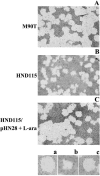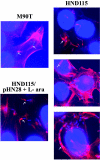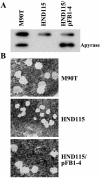Apyrase, the product of the virulence plasmid-encoded phoN2 (apy) gene of Shigella flexneri, is necessary for proper unipolar IcsA localization and for efficient intercellular spread
- PMID: 16452446
- PMCID: PMC1367242
- DOI: 10.1128/JB.188.4.1620-1627.2006
Apyrase, the product of the virulence plasmid-encoded phoN2 (apy) gene of Shigella flexneri, is necessary for proper unipolar IcsA localization and for efficient intercellular spread
Abstract
The role in virulence of the Shigella flexneri ospB-phoN2 operon has been evaluated. Here we confirm that OspB is an effector and show that apyrase, the product of phoN2, may be a virulence factor, since it is required for efficient intercellular spreading. Apyrase may be important in a deoxynucleoside triphosphate-hydrolyzing activity-independent manner, suggesting that it may act as an interaction partner in the process of IcsA localization.
Figures






Similar articles
-
Polar localization of PhoN2, a periplasmic virulence-associated factor of Shigella flexneri, is required for proper IcsA exposition at the old bacterial pole.PLoS One. 2014 Feb 27;9(2):e90230. doi: 10.1371/journal.pone.0090230. eCollection 2014. PLoS One. 2014. PMID: 24587292 Free PMC article.
-
Evaluation by real-time PCR of the expression of S. flexneri virulence-associated genes ospB and phoN2 under different genetical backgrounds.Int J Immunopathol Pharmacol. 2008 Jul-Sep;21(3):707-14. doi: 10.1177/039463200802100325. Int J Immunopathol Pharmacol. 2008. PMID: 18831939
-
Establishment of unipolar localization of IcsA in Shigella flexneri 2a is not dependent on virulence plasmid determinants.Infect Immun. 1999 Jan;67(1):350-6. doi: 10.1128/IAI.67.1.350-356.1999. Infect Immun. 1999. PMID: 9864236 Free PMC article.
-
Shigella flexneri: genetics of entry and intercellular dissemination in epithelial cells.Curr Top Microbiol Immunol. 1994;192:217-41. doi: 10.1007/978-3-642-78624-2_10. Curr Top Microbiol Immunol. 1994. PMID: 7859507 Review. No abstract available.
-
DsbA: a protein-folding catalyst contributing to bacterial virulence.Microbes Infect. 1999 Dec;1(14):1221-8. doi: 10.1016/s1286-4579(99)00239-7. Microbes Infect. 1999. PMID: 10580278 Review.
Cited by
-
Analysis of Soluble protein complexes in Shigella flexneri reveals the influence of temperature on the amount of lipopolysaccharide.Mol Cell Proteomics. 2013 May;12(5):1250-8. doi: 10.1074/mcp.M112.025270. Epub 2013 Feb 2. Mol Cell Proteomics. 2013. PMID: 23378524 Free PMC article.
-
Molecular pathogenesis of Shigella spp.: controlling host cell signaling, invasion, and death by type III secretion.Clin Microbiol Rev. 2008 Jan;21(1):134-56. doi: 10.1128/CMR.00032-07. Clin Microbiol Rev. 2008. PMID: 18202440 Free PMC article. Review.
-
Analysis on the interaction domain of VirG and apyrase by pull-down assay.Molecules. 2014 Nov 5;19(11):18090-101. doi: 10.3390/molecules191118090. Molecules. 2014. PMID: 25379645 Free PMC article.
-
T Follicular Helper Cells Promote a Beneficial Gut Ecosystem for Host Metabolic Homeostasis by Sensing Microbiota-Derived Extracellular ATP.Cell Rep. 2017 Mar 14;18(11):2566-2575. doi: 10.1016/j.celrep.2017.02.061. Cell Rep. 2017. PMID: 28297661 Free PMC article.
-
Identification of novel substrates of Shigella T3SA through analysis of its virulence plasmid-encoded secretome.PLoS One. 2017 Oct 26;12(10):e0186920. doi: 10.1371/journal.pone.0186920. eCollection 2017. PLoS One. 2017. PMID: 29073283 Free PMC article.
References
-
- Babu, M. M., S. Kalamalakkannan, Y. V. B. K. Subrahmanyam, and K. Sankaran. 2002. Shigella apyrase-a novel variant of bacterial acid phosphatases? FEBS Lett. 512:8-12. - PubMed
-
- Berlutti, F., M. Casalino, C. Zagaglia, P. A. Fradiani, P. Visca, and M. Nicoletti. 1998. Expression of the virulence plasmid-carried apyrase gene (apy) of enteroinvasive Escherichia coli and Shigella flexneri is under the control of H-NS and the VirF and VirB regulatory cascade. Infect. Immun. 66:4957-4964. - PMC - PubMed
-
- Bernardini, M. L., J. Mounier, H. d'Hauteville, M. Coquis-Rondon, and P. J. Sansonetti. 1989. Identification of icsA, a plasmid locus of Shigella flexneri that governs bacterial intra- and intercellular spread through interactions with F-actin. Proc. Natl. Acad. Sci. USA 86:3867-3871. - PMC - PubMed
-
- Bhargava, T., S. Datta, V. Ramakrishnan, R. K. Roy, K. Sankaran, and Y. V. B. K. Subrahmanyam. 1995. Virulent Shigella codes for a soluble apyrase: identification, characterization and cloning of the gene. Curr. Sci. 68:293-300.
Publication types
MeSH terms
Substances
LinkOut - more resources
Full Text Sources
Other Literature Sources

